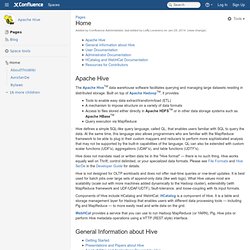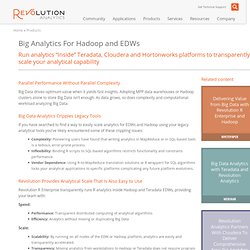

TripleMap.
Extend, visualize and share data online. Bust your data out of its silo!

Get more from data with Fusion Tables. Fusion Tables is an experimental data visualization web application to gather, visualize, and share data tables. Visualize bigger table data online Filter and summarize across hundreds of thousands of rows. Then try a chart, map, network graph, or custom layout and embed or share it. Two tables are better than one! Merge two or three tables to generate a single visualization that includes both sets of data. Make a map in minutes Host data online - and stay in control Viewers located anywhere can produce charts or maps from it. Meet the combo powering Hadoop at Etsy, Airbnb and Climate Corp. — Data. SQLstream. Data Science Toolkit. Advanced Reporting & Analysis for Big Data.
Cassandra vs MongoDB vs CouchDB vs Redis vs Riak vs HBase comparison. (Yes it's a long title, since people kept asking me to write about this and that too :) I do when it has a point.)

While SQL databases are insanely useful tools, their monopoly in the last decades is coming to an end. And it's just time: I can't even count the things that were forced into relational databases, but never really fitted them. (That being said, relational databases will always be the best for the stuff that has relations.) But, the differences between NoSQL databases are much bigger than ever was between one SQL database and another. This means that it is a bigger responsibility on software architects to choose the appropriate one for a project right at the beginning. In this light, here is a comparison of Open Source NOSQL databases Cassandra, Mongodb, CouchDB, Redis, Riak, RethinkDB, Couchbase (ex-Membase), Hypertable, ElasticSearch, Accumulo, VoltDB, Kyoto Tycoon, Scalaris, OrientDB, Aerospike, Neo4j and HBase: The most popular ones Redis (V3.2) Cassandra (2.0) MongoDB (3.2)
MongoDB. Welcome to Apache™ Hadoop™! Home - Apache Hive. The Apache HiveTM data warehouse software facilitates querying and managing large datasets residing in distributed storage.

Built on top of Apache HadoopTM, it provides Tools to enable easy data extract/transform/load (ETL)A mechanism to impose structure on a variety of data formatsAccess to files stored either directly in Apache HDFSTM or in other data storage systems such as Apache HBaseTM Query execution via MapReduce Hive defines a simple SQL-like query language, called QL, that enables users familiar with SQL to query the data. At the same time, this language also allows programmers who are familiar with the MapReduce framework to be able to plug in their custom mappers and reducers to perform more sophisticated analysis that may not be supported by the built-in capabilities of the language. QL can also be extended with custom scalar functions (UDF's), aggregations (UDAF's), and table functions (UDTF's).
Components of Hive include HCatalog and WebHCat. Hadoop Download. Maui-indexer - Maui - Multi-purpose automatic topic indexing. Summary Maui automatically identifies main topics in text documents.

Depending on the task, topics are tags, keywords, keyphrases, vocabulary terms, descriptors, index terms or titles of Wikipedia articles. Maui performs the following tasks: term assignment with a controlled vocabulary (or thesaurus) subject indexing topic indexing with terms from Wikipedia keyphrase extraction terminology extraction automatic tagging It can also be used for terminology extraction and semi-automatic topic indexing. New:Try out Maui demo! Important: Questions regarding usage, bug reports or support? Also: read more on Download, Installation and Usage pages. Domain and language independence Maui has been successfully tested on computer science, agricultural, medicine, physics, biology, bioinformatics documents, as well as on blog posts and news articles. Examples are provided in Maui's Wiki pages Background Maui has been developed by Olena Medelyan as a part of her PhD project, under supervision of Ian H.
I - RapidMiner. Using Revolution R Enterprise With Apache Hadoop for 'Big Analytics' Parallel Performance Without Parallel Complexity Big Data drives optimum value when it yields fast insights.

Adopting MPP data warehouses or Hadoop clusters alone to store Big Data isn’t enough. As data grows, so does complexity and computational workload analyzing Big Data. Big Data Analytics Cripples Legacy Tools If you have searched to find a way to easily scale analytics for EDWs and Hadoop using your legacy analytical tools you’ve likely encountered some of these crippling issues: Complexity: Pioneering users have found that writing analytics in MapReduce or in SQL-based tools is a tedious, error-prone process.Inflexibility: Binding R scripts to SQL-based algorithms restricts functionality and constrains performance.Vendor Dependence: Using R-to-MapReduce translation solutions or R wrappers for SQL algorithms locks your analytical applications to specific platforms complicating any future platform evolutions.
Revolution Provides Analytical Scale That Is Also Easy to Use. Chorus: Productivity engine for Data Science Teams.